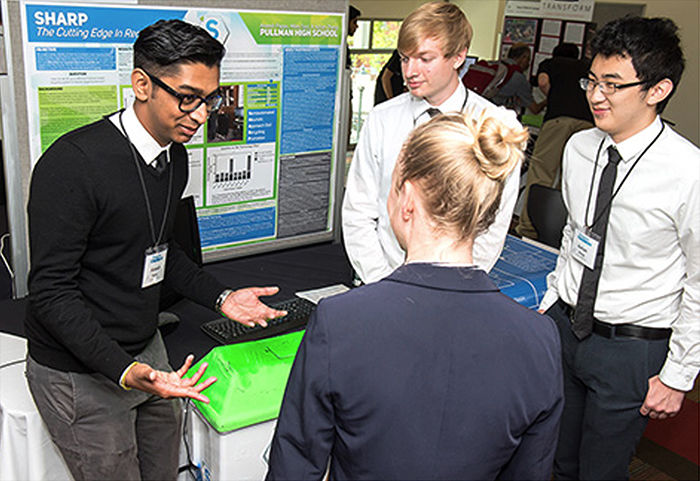High school students compete in sustainability competition
May 24, 2017
WSU hosted 400 high school students for the 10th annual Imagine Tomorrow competition over the weekend.
The competition brings together some of the brightest high school students from around the Northwest in an effort to promote problem-solving ideas in environmental sustainability.
The event was Friday through Sunday, with the main events taking place in Beasley Coliseum on Saturday. The competition was steep, featuring over 30 high schools from Washington and another four from Idaho. These schools entered more than 100 projects.
Davie Ross, Naba Deyab and Ben Hlavsa, freshmen from Aviation High School in Seattle, said they had been working on their project since December 2016. The project, ‘The Future is Stirling,’ was an experiment to see if Stirling engines could be used as a renewable resource.
“After seeing our results, we want to take things to a grander scale,” Ross said.
Hlavsa, deemed the head engineer on the project, was credited with making the models used in the experiments.
“Engines are kind of my thing,” he said. “I want to go into aeronautical engineering and design jet engines.”
Edward Bogachuk, a freshman from Camas High School and member of another group, said his group was interested in multiple sources of renewable energy.
“We wanted to build a machine capable of harnessing energy from the wind, the sun and the water all in one machine,” Bogachuk said.
Benjamin Glassmire, also a freshman from Camas High School, said his group started testing in December.
“This project has been our entire school year,” Glassmire said.
The competition’s funding was almost entirely covered by the sponsors of the event, said Jennifer Dean, director of Development for Imagine Tomorrow.
“The only responsibility the students had was getting to Pullman, the rest was covered,” Dean said.
Imagine Tomorrow is a great way for students to get interested in STEM projects, she said.
Students at the event have high expectations for themselves, with some saying they wanted to get into some of the nation’s top schools. Although the competition was designed to get students interested in STEM, some of them have different careers in mind. Ross, for example, wants to go into aviation law.
Law was popular among other project groups as well. Bogachuk and Glassmire both agreed that they would not mind going into the STEM field, but they would prefer to go into law.
Most of the judges for the competition were representatives from the sponsors of the event, such as Alaska Airlines, Boeing, Puget Sound Energy and McKinstry.
“The judges are looking for the data, future improvements and the overall engineering quality,” Bogachuk said.
John Palmer, a judge and representative from Boeing, said judges have a clearly-defined rubric.
“Objectives, creativity, inquiry, thoroughness and presentation are all coming into play,” Palmer said.
One of the judges’ jobs is to determine which presentations stand out.
“Getting to the point, trying to investigate how they approached [the topic] and the end results,” Jim Russell, also a Boeing representative, said. “It’s good to have flavor, but the basis is we’re judging their engineering accomplishment.”
The competition wrapped up Saturday night with keynote speaker Tom Ranken, the President and CEO of CleanTeach Alliance.
The winners, which have yet to be announced, took home $300 per student and $1,500 for their school, all funded through sponsorship.





















